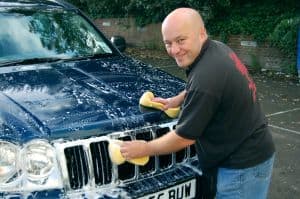In the English language, usually we use a past tense to describe something in the past.
Example:
Jane: What did you do yesterday?
(Question about the past)
Possible answers:

I washed my car.

I made a pizza.
In these sentences, the past form describes something happening in the past. But in some situations, we use the past form to describe the present or future!
In this lesson, you will learn 5 situations in which we use the past form to describe the present or future:
- Second conditionals
- Suggestions with “suppose”
- The structure “It’s time…”
- “would rather”
- Distancing in questions
Let’s look at each one in more detail.
Second conditionals
The second conditional describes an imaginary, impossible or unlikely situation in the present or future.
Example:

If I had a lot of money, I would buy a boat.
Meaning and explanation:
In reality, I do not have a lot of money. The situation is hypothetical. I use the second conditional to imagine having a lot of money in the present or future.
The past tense is indicating a distance from reality. It is not indicating past time.
More examples:

If she studied, she would pass the exam.
If he washed the dishes, his mother would be pleased.
In both of the above sentences, the past tense describes the present or future.
Suggestions with “suppose”
We use ‘suppose’ in the imperative to make a suggestion.
The meaning is “What if?”
We use “suppose” + past tense if the plans are not definite or certain.
The form is the past tense but the meaning is the future.
Examples:

Suppose we moved to New York?
Suppose we had a glass of wine?
The structure “It’s time…”
Form: It’s time + subject + past tense
Meaning: It’s time for someone to do something (in the present or future).
Examples:

She’s tired. It’s time she went to bed.
Your shoes are dirty. It’s time you washed them.
“would rather”
Form: subject + would rather + subject + past tense
Meaning: would prefer someone to do something (in the present or future).
Examples:

Mark: Do you want to go to Paris with me on Sunday?
Jane: I would rather we went on Saturday.
Child: Can I play in the living room?
Mother: I would rather you played in the garden.
Distancing in questions and requests
The past tense distances ourselves from the present reality.
This use of the past tense makes a question or request more polite because it is less direct.
The form is the past tense but the meaning is the present or future.
Example structure: “Did you want?”
Meaning: “Do you want?”
Example sentences:

Waiter: Did you want a glass of wine with your meal, madam?

Receptionist: Did you want a single or double room, sir?
Example structure: “I wondered..”
Example sentences:

I wondered if you were free tomorrow.
I wondered if you wanted to go shopping.
Using the past continuous
We also use the past continuous to make questions and requests less direct. The form is the past continuous but the meaning is the present.
Example sentence:

(In a clothes shop)
Were you looking for a particular colour, sir?

